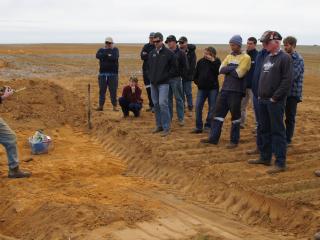Examining methods of lime incorporation to best suit the farm business has been the focus of recent Department of Agriculture and Food (DAFWA) field walks in the northern Wheatbelt.
DAFWA development officer Wayne Parker said growers had the opportunity to examine demonstration sites at Carnamah, Morawa and Binnu using different techniques to incorporate lime at depth.
Mr Parker said improving the time for return on lime investment was front of many growers’ minds.
“Great extension work by DAFWA researcher Chris Gazey over the past two years has highlighted the need to address low pH in the soil below 10cm,” Mr Parker said.
“Combine this with the dry periods during the winter of recent years and reduced yield as a direct impact of poor soil, and growers are hungry for information on getting lime to depth.”
A collaboration between DAFWA and Northern Agricultural Catchments Council (NACC), with funding support from the Australian Government, features demonstration sites that are using tillage to achieve lime burial to depths below 10cm.
“This series of demonstrations is about protecting and improving your soil resource,” Mr Parker said.
“A key message from the field walks was that growers need to look at why they till – is it to incorporate lime, improve weed control, renovate compaction, reduce the influence of non-wetting soil or is it a combination of these things.
“Understanding cost, speed and timeliness is important when considering the tillage option for your business.”
Implements used reflect the potential return at each site. Those used at Carnamah are not the same as those at Morawa or Binnu. Common to each demonstration is the offset disc and a deep ripping treatment.
Where the mouldboard plough had been used (Binnu and Carnamah), lime was layered at the depth of working, approximately 25cm, and not evenly distributed through the working.
“Whenever a mouldboard is used it is important to know the pH of the soil being brought to the surface,” Mr Parker said. “A low sub surface pH brought to the surface will prove difficult for crop establishment.
“The offset disc provides speed and thorough mixing to the working depth. Working depth of the offset is approximately 10cm. This method of incorporation does little to change soil compaction or non-wetting.
“A spader will achieve similar level of mixing to the offset disc. However, mixing is to greater depths. Spading has a positive impact on non-wetting and soil compaction. This comes at a far greater cost and slower speed.”
Mr Parker said much discussion focused on the ability of the deep ripper to get lime to depth, particularly as this was a process that many growers already have as part of their paddock preparation.

Media contacts: Jodie Thomson/Megan Broad, media liaison +61 (0)8 9368 3937
